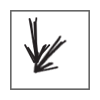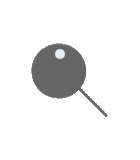Discover your intellectual strengths
Inductive reasoning, or abstract reasoning as it is sometimes called, involves identifying rules and finding relationships among seemingly unrelated information.
In the example below, rules are established according to the number of segments, and segment colors.
Example: Which object comes next?

Answer:

'Complete the sequence' is the more commonly found mode. In addition, the rules for the shapes usually become more complex from beginning to end.
The rules governing sequences mainly involve position, movement, and rotation.
Logical induction shape sequences
Example 1: Which object comes next?


Example 2: Which object comes next?


Example 3: Which object comes next?


Example 4: Which object comes next?


Example 5: Which object comes next?


Example 6: Which object comes next?


The following two rules apply:
1. Spots alternate with solids.
2. Line rotates CW as follows: 90°, 180°, 270°, 360°, 90°.
Example 7: Which object comes next?

